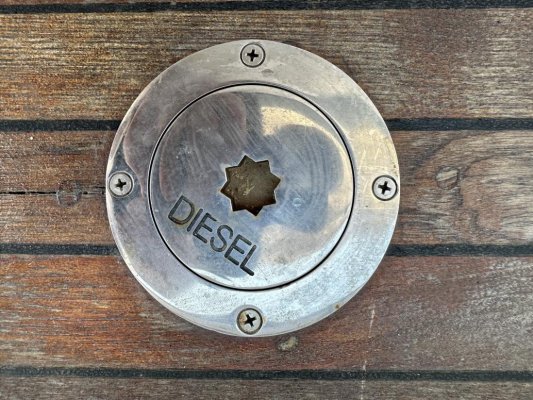2nd story (sorry Peter, for somewhat hijacking the thread, but you'll find this interesting!)
A story was recently related to me by a guy that had a trawler on the East Coast. He was fairly new to trawlers and purchased a Taiwanese trawler, I believe it was a Marine Trader, 44? Anyway, twin engine. Within a few months of purchasing it, he stayed at a marina for several days. The day they left, they checked everything out, fired up the engines, and left the dock. They got about a mile away from the dock, and both engines started running really rough, then quit. He tried restarting, no go. Checked the fuel filters, and they were full of crap. More on that later

. . .
He got towed back to the marina, same slip.
After much investigation, they finally figured out what the problem was. . . .
- Turned out that what happened was that someone in the marina had requested that the Honey Boat pump out their boats holding tank.
- The Honey Boat went to the wrong slip, his boat.
- One of the fuel tank filler caps was incorrectly marked "Waste" instead of "Diesel". The previous owner accidentally dropped the original cap in the water, and had replaced the cap, but couldn't find a "Diesel" labeled cap, so replaced it with the only one he could find, which was marked "Waste"
 . . .
. . .
- The Previous Owner knew it.
- The Current Owner knew it, having been told by the Previous Owner.
- The cap key had a big tag on it stating that the STBD fuel cap was incorrectly labeled as "Waste".
- The only people who handled the fueling was the Owner and his Wife.
Here's where it gets REALLY stinky!
- The Operator of the Honey Boat went to the wrong slip (his boat)
- He identified the cap labeled as "Waste", started pumping out the tank.
- After pumping an estimated 40 gallons from the tank, he apparently realized from the color of the liquid filling his translucent plastic tank that he was removing fuel . . . . Now for the good part . . . .
- Instead of Stopping, and Admitting his Mistake . . . . .
- HE PUMPED ABOUT 40 GALLONS OF WHAT WAS MIXED UP IN HIS TANK BACK INTO THE FUEL TANK!


- Then he left, not saying anything to anyone . . . .

- Seeing what was going on, a neighboring boat owner came over, and when they realized what had happened, he told them that he had seen the Honey Boat at the boat the previous day, and the ball got rolling from there . . .
Sooooo, The operator of the Honey Boat stated that since the cap was mislabeled, he was not responsible for any damages incurred.
- The boat owner called the police, filing a police report for trespassing, as well as for damage incurred to his boat, stating that the mis-labeled cap would never have come into play if the Honey Boat Operator had gone to the correct boat and not trespassed on his boat. The police sided with the boat owner.
- The Honey Boat operator ended up paying to have a company pump the tanks, flush the lines, etc.
- The engines still ran rough.
- The Honey Boat Operator paid for rebuilding the injector pumps, as well as the injectors, which solved the running rough issue.
- The boat owner contacted the manufacturer of the engines (one of which had recently been rebuilt and was still under warranty) The company stated that the warranty on that engine was now void, and that the only way to re-establish the warranty was to rebuild the engines again . . . .
Ultimately, the Honey Boat operator settled, already having paid for the flushing, rebuilding of injector pumps and injectors, and now paying the owner for the estimated cost of rebuilding both engines, as well as reimbursing the owner for the "loss of use" up to that point, as well as an estimated 3 months of "loss of use" for the rebuilds.
The owner stated that he never did get the engines rebuilt, putting the money in a boat maintenance account. As the incident happened about 8 years prior, he figured he was money ahead! (Oh, and he replaced the cap with the correctly labeled one!)
The owner told me that he was convinced that the engines had suffered no lasting damage.
So, Peter, your problem could have been worse, MUCH worse!


 . . .
. . . 


